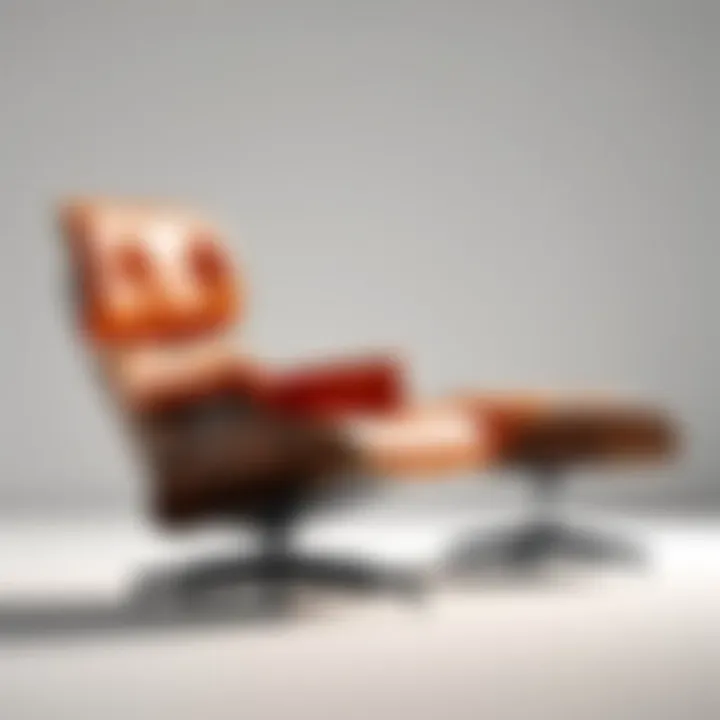The Impact of Eames Design on Modern Aesthetics


Intro
In the heart of mid-century modern design resides an influence that reshaped how we view aesthetics and usability. Charles and Ray Eames embodied a philosophy that transcends mere furniture making; their vision intertwined design with life, merging beauty with function. This article will journey through their remarkable contributions, exploring not just their iconic pieces, but also the driving principles behind their work.
From the polished curves of the Eames Lounge Chair to the innovative use of molded plywood, we will uncover how these creations remain relevant in today's design language. By diving into their methodologies, we aim to understand how the Eames' legacy persists, resonating in modern aesthetics while inspiring new generations of designers.
As we navigate through their historical context, key design principles, and an examination of their most recognized works, consider how their insights might apply to contemporary challenges in the design realm.
Design Philosophy
The Eames duo believed that design should serve a purpose without sacrificing elegance. They often remarked that good design is a balance between usefulness and beauty. This emphasis on practicality informed their approach to creating pieces that weren't just visually arresting, but also comfortable and functional.
- Versatility: One key element was the ability of their designs to fit seamlessly into various environments. The molded plywood chairs, for example, serve both home and public spaces alike.
- Sustainability: The Eames were ahead of their time in their consideration for materials that minimize waste. They actively sought alternatives to conventional manufacturing processes, making their ethos about more than just aesthetics.
With these principles in mind, it becomes evident how the Eames not only crafted furniture but also sculpted an approach to living that values both practicality and artistry. Their work serves as a reminder that design's true purpose lies in its ability to enhance human experience.
Design Showcase
Among the many masterpieces the Eames designed, several stand out as exemplifying their philosophy.
Eames Lounge Chair
Considered a benchmark for comfort and style, the Eames Lounge Chair introduced a new level of relaxation and functionality. It comprised a molded wood shell and leather cushions that cradle the body effectively. This chair encapsulates their belief that luxury doesn’t need to be exclusive or impractical.
"The role of the designer is that of a very good, thoughtful host anticipating the needs of his guests."
— Charles Eames
Molded Plywood Chairs
The Molded Plywood Chairs, particularly the LCW model, illustrate a pivotal moment in design history. These chairs showcase not only the aesthetic appeal but the ingenious craftsmanship that would later influence numerous industries. With its ergonomic design and minimal footprint, it continues to serve a multitude of settings, from cafes to art galleries.
Contemporary Relevance
The Eames philosophy is not a relic of the past but thrives within modern design frameworks. Today’s designers draw inspiration from their methods, integrating sustainable practices and user-centered approaches in ways that would make the Eames proud.
In a world inundated with disposable culture, the emphasis on longevity through timeless design is a refreshing reminder of what quality entails. This commitment to crafting meaningful experiences rather than just products commands attention and respect in the current landscape.
Ending
As we reflect on the bold designs of Charles and Ray Eames, we also recognize their profound influence on today’s design practices. Their ideas remind us that true innovation arises not from the surface but from understanding the intricate connection between aesthetics and functionality.
While their iconic pieces remain a standard of excellence, it is their underlying philosophy that inspires designers today. The essence of Eames design is alive, shaping the very fabric of modernity, and inviting us all to rethink the role of design in life.
Historical Overview of Eames Design
Understanding the historical context of Eames design is pivotal for grasping its significance and impact. Established in the mid-20th century, the Eames duo—Charles and Ray Eames—has left an indelible mark on various design fields, melding aesthetics, practicality, and innovation. Their legacy isn’t just about furniture; it spans architecture, art, and multimedia presentations. In this section, we trace their evolution, the socio-cultural landscape they navigated, and how their philosophies came to shape a modern understanding of design.
The Eames Duo: Charles and Ray Eames
The story of Eames design begins with two visionary figures, Charles and Ray Eames, who partnered not only in life but in their profound creative endeavors. Charles Eames, trained as an architect, brought structural rigor to their concepts, while Ray Eames, initially a painter, infused artistry into their work. Together, they forged a design partnership that challenged norms and predicted future trends. Their marriage was a fusion of ideas and talents, which allowed them to explore new frontiers in design. The craftsmanship they emphasized was about more than aesthetics; it was about creating user-friendly and inclusive designs that could resonate and stand the test of time.
The Birth of Mid-Century Modern Design
Mid-century modern design, which took shape post-World War II, represents a cultural shift towards simplicity, form, and function. It emerged as a response to the complex and ornate styles of earlier periods, embracing clean lines and organic shapes. Eames designs epitomized these characteristics, embodying a seamless blend of functionalism and artistic expression. At a time when industrial design was gaining momentum, their approach to production methods revolutionized not only furniture design but also the very way everyday objects could serve a purpose. Their notable motto—to create designs that looked good while feeling good—defined the ethos of an era where form met function harmoniously.
Influences on Eames Design Philosophy


Several influences helped shape the Eames design philosophy, drawing from various fields and movements. They were deeply inspired by the Bauhaus principles, which advocated for unity among art, craft, and technology. This appreciation for materials, structure, and function led to innovations in the use of molded plywood and fiberglass, resulting in groundbreaking product designs. Furthermore, Eames' philosophy embraced the concept of playfulness in design. The couple believed that creativity flourishes in a light-hearted setting, which influenced their approach to both design and life. Their dedication to research and technology also guided their work, where experimentation with new materials and techniques became a hallmark of their identity.
"Design is a plan for arranging elements in such a way as to accomplish a particular purpose." — Charles Eames
In summary, the historical overview of Eames design frames their contributions not just as products but as cultural artifacts that continue to inform the dialogue around functionality, aesthetics, and innovation today. Understanding these elements paints a clear picture of the lasting impact Charles and Ray Eames have had on the world of design.
Foundational Principles of Eames Design
Delving into the foundational principles of Eames design reveals the core tenets that propelled Charles and Ray Eames into the limelight within the world of design. These principles act as a compass, guiding their creative journey and bridging the gap between aesthetics and functionality. Understanding these elements also showcases how their philosophies not only transformed mid-century design but continue to resonate in today’s fast-paced design environment.
Interplay of Aesthetics and Functionality
The delicate balance between aesthetics and functionality is perhaps the hallmark of Eames design. Rather than viewing these concepts as opposing forces, the Eames duo saw them as intertwined elements that strengthen each other. They believed that beauty should not come at the expense of usability. For example, their iconic lounge chair isn’t just a pretty piece of furniture; it's designed to offer exceptional comfort and support, aligning form with purpose. The gracefulness of the curves in the chair's silhouette not only pleases the eye but also invites people to recline and relax in it. This synergy provides a practical take on form while avoiding any overly decorative details that could overwhelm the sense of simplicity.
Eames's ethos also challenges the idea that art is separate from everyday life. They sought to bring art into the home through objects that could be enjoyed and used daily. To them, design should enhance the human experience in tangible ways. In today’s dizzying array of consumer products, remembering this interplay is essential for contemporary designers aiming to create pieces that echo the Eames legacy.
Innovative Use of Materials
Innovation in material usage wove a distinct thread through Eames design. Charles and Ray experimented boldly with materials that were not typically associated with furniture crafting. They embraced molded plywood, a choice that instantaneously reshaped seating solutions across the globe. This radical shift not only revolutionized the manufacturing process by allowing for new, ergonomic shapes but also made furniture more accessible in terms of production costs.
Their foray into fiberglass for shell chairs marks another milestone; it’s a fine example of how material innovation can lead to breakthrough forms that are also practical. The method of producing these items not only harnessed the strength of fiberglass but also allowed for a spectrum of colors and textures, contributing to the visual diversity in a home or an office. This leap into new materials still encourages designers to think beyond traditional resources when creating new artifacts, proving that adaptability is key to sustained relevance.
Human-Centric Design Approach
A human-centric approach lies at the very heart of Eames design philosophy. Understanding the user experience took precedence over all else. This is evidenced by the way they meticulously designed spaces and furniture with the end-user in mind. From the start, they would delve into how individuals would interact with their designs, ensuring that comfort and usability were not mere afterthoughts.
The Eameses often referenced their desire to create products that were meant to enrich lives, adapting their designs to meet the nuanced needs of the people. Discerning features such as the angle of a chair back or the height of a table reflect an unwavering commitment to human orientation. This focus has paved the way for subsequent generations of designers to prioritize usability while maintaining aesthetic integrity.
"The role of design is not to make things more beautiful, but to make things that make the world more beautiful."
— Charles Eames
As we wander through the ever-evolving landscape of design today, the principles of Eames stand as guiding lights, reminding us to create with thoughtfulness, innovation, and a touch of beauty that speaks to the human experience.
Iconic Works of Eames Design
The Eames design legacy is rooted firmly in its iconic works—pieces that not only epitomize aesthetic beauty but also delve into practicality, reshaping how we perceive functional art. These designs are not just furniture; they're cultural beacons, representing an era but also pushing the boundaries of what can be achieved in modern design principles. The dialogue between simplicity and sophistication reveals the thinking that made Eames revered in the design world.
The Eames Lounge Chair: A Cultural Staple
The Eames Lounge Chair stands tall as a cultural staple, embodying a timeless elegance that has not only graced homes but also influenced the very air of sophistication in modern design. Made in the late 1950s, this piece was revolutionary for its use of molded plywood, a process that offered both comfort and modernity. Its classic leather upholstery and relaxed seating position appeal to those who appreciate a blend of leisure and luxury.
The chair's curved lines and organic forms cater to the human body, making it not just a pretty face but a throne for relaxation. It's the type of chair that one could lose oneself in, perhaps with a book in hand, suggesting that beauty can coexist seamlessly with comfort.
"The Eames Lounge Chair is a celebration of design that prioritizes the human experience above all."
Moreover, it's become an icon prominently featured in media, from television shows showcasing stylish interiors to being a coveted piece in chic modernist homes. It's not just furniture; it's a statement.
The Molded Plywood Chairs: A Revolution in Seating
Molded Plywood Chairs represent a chapter where design met innovation head-on. These chairs emerged as a result of Charles and Ray Eames’ experimental spirit, utilizing a technique that bent plywood into sinuous shapes. Before their inception, the concept of comfortable, aesthetically pleasing chairs constructed from plywood was virtually unheard of.
Historically, these chairs broke the barriers of manufacturing, leading to a new age where furniture wasn’t necessarily heavy and cumbersome. Light-weight yet sturdy, these pieces are perfect for various settings—from homes to galleries to offices. The versatile design caught the eye of many and made it possible for artists, designers, and the general public alike to embrace modernism in their lives. Their minimalist approach appealed equally to the sophisticated and the casual, catering to diverse tastes and environments alike.
The Eames Storage Unit: Function Meets Form
The Eames Storage Unit showcased a different facet of their design philosophy—an embrace of modularity and flexibility. In a time when storage solutions typically adhered to rigid designs, the Eames Storage Unit broke those conventions by providing a versatile platform that could adapt to various needs. Its innovative system featured shelves and compartments arranged in a way that encouraged creativity and personal expression.


Constructed from a melange of materials, including wood and metal, the unit's balanced aesthetic hints at the harmony between utility and style. Whether used in a bedroom, a study, or an office, it creates an environment that feels organized yet lively. This design allows for personal flair, encouraging users to curate their space uniquely.
The Eames Storage Unit embodies their vision of an ideal lifestyle—one where functionality does not undermine aesthetic beauty. It’s a design philosophy that continues to resonate, urging contemporary designers to rethink how we allocate and display our belongings in ways that enrich our surroundings.
Through each of these iconic works, the Eames’ signature style emerges, weaving a narrative that transcends decades, encouraging both beauty and utility to inform future interpretations of modern design.
Impact of Eames Design on Contemporary Practices
The duo of Charles and Ray Eames has undeniably left an indelible mark on the design landscape, influencing multiple domains far beyond their original mid-century modern roots. This section delves into how their principles continue to inform modern aesthetics, emphasizing the intersection of functionality and beauty. The impact is seen not only in tangible products but also in the methodologies embraced by contemporary designers.
Lasting Influence on Modern Designers
The Eames' philosophy is like a breath of fresh air for new generations of designers. Emerging design talent looks to their work as a touchstone for quality and innovation. In a world that often prioritizes quick turnover and trends, the Eames remind us that good design should have longevity. Examples abound, such as the rise of biophilic design, where natural materials and forms are inspired by Eames’ holistic approach to furniture that interacts well with human use.
Modern designers such as Patricia Urquiola and Jasper Morrison incorporate the Eames ethos into their creations, blending aesthetic appeal with practicality. At workshops and studios, young designers often reference the Eameses in discussions on project philosophy, eager to echo the comprehensive thinking that characterized their output. Their principles seem to transcend the mere visual; they prompt designers to think about how the user interacts with objects in daily life.
Eames Design in Contemporary Architecture
The architectural field has not remained immune to the influence of Eames design. Notable architects today utilize principles such as modularity and open spaces, concepts championed by the Eames. The harmonic integration of form and function continues to shape residential and commercial projects alike.
For instance, the works of firms like Studio Gang and BIG (Bjarke Ingels Group) reveal a traceable line back to the ideas put forth by the Eames. These entities adapt the concept of fluidity in space, allowing for an adaptable layout that enhances livability. The connection between the inside and outside spaces echoes the Eames’ explorative use of materials and designs that invite interaction—not just between people but also between the structure and its environment.
"Design is a plan for arranging elements in such a way as to accomplish a particular purpose." - Charles Eames
Adapting Eames Principles in Digital Design
The transition from physical to digital design brings a fresh set of challenges. Yet, the Eames’ principles of clarity and simplicity have been remarkably adaptable to this new canvas. As technology progresses, designers find themselves echoing the Eames mantra: design should be approachable and foster connection.
In user-interface design, for example, the notion of user-centric principles is highly inspired by the Eames approach to furniture. The focus now is on seamless interactions—that the technology should feel intuitive and support the user’s tasks. This aspect can be seen in companies like Apple, which prioritize clean design and functionality, marrying the visual elements with ease of use, a clear nod to lessons gleaned from the Eames legacy.
Furthermore, designers in the digital realm incorporate vibrant color palettes and smooth interfaces reminiscent of the Eames’ bold yet functional furniture styles. Today’s digital designers are tasked with creating experiences, not just visual content, leading to a design philosophy where an emotional connection is cultivated through thoughtful aesthetics and interaction.
In summary, the legacy of Eames design permeates the fabric of contemporary practices across multiple fields. Modern designers sculpt their works using the enduring principles of the Eames, ensuring that functionality and beauty continue to thrive hand in hand.
The Cultural Significance of Eames Design
The essence of Eames design transcends mere aesthetics; it profoundly impacts cultural identity and societal dynamics. This section explores how the work of Charles and Ray Eames is interwoven with American identity, popular culture, and various art forms. Understanding this cultural significance deepens appreciation for their contributions and reveals the enduring relevance of their design philosophy.
Eames and American Identity
Charles and Ray Eames are often seen as the embodiment of American innovation. Their designs reflect the spirit of a post-war America that was swift to embrace modernization and change. At the heart of their work lies an understanding that design could be both functional and beautiful, which echoed the aspirations of a nation eager to reinvent itself.
Their molded plywood chairs and lounge chairs didn’t just serve a purpose; they became symbols of comfort and style, representing a new lifestyle rooted in simplicity and efficiency. This link to American design culture established a narrative where utility meets art. People began to associate the Eames name with not just furniture but an entire way of approaching life—one that valued creativity, progress, and community. To the layperson, Eames designs symbolize a time of optimism, aligning perfectly with the American Dream.
Eames designs serve as a mirror to American culture, reflecting both the aspirations and achievements of its time while challenging norms.
Eames in Popular Culture
The reach of Eames design extends well beyond architecture and furniture. Icons like the Eames Lounge Chair have made appearances in films, television shows, and even music videos, embedding themselves into the fabric of pop culture. For instance, in the series Mad Men, the Eames Lounge Chair acts as a prop that signifies sophistication and success, embodying the era’s aesthetic ideals.
Social media platforms—especially Instagram and Pinterest—boast countless posts celebrating these designs, further solidifying their status. The visual appeal of Eames pieces lends themselves to creative interpretations, and today, influencers often incorporate Eames-inspired furniture into modern home aesthetics. This blend of vintage and contemporary reflects an ongoing conversation about style and functionality in our digital age.
Eames Design in Art and Media
Eames designs have not only influenced the realm of furniture but also the world of art and media. Their approach to design has inspired artists and filmmakers alike, capturing the essence of mid-century modernism. Documentaries and educational programs, like Helvetica which focuses on design's impact on culture, often reference Eames work to illustrate principles of visual clarity and simplicity.


In visual arts, their playful use of colors and shapes can be seen in many contemporary artists’ works. The Eames couple didn’t just create furniture; they fostered a dialogue about space, environment, and aesthetics. Their films, such as Powers of Ten, invite viewers to explore design from microscopic levels to the cosmos, merging art, science, and philosophy in one brief experience.
Thus, the work of Charles and Ray Eames remains significant not just for its form and functionality but for its pervasive influence across multiple cultural landscapes. Their designs encourage us to think critically about what it means to live in a thoughtfully designed space.
Eames Design Today: Relevance and Adaptation
The Eames design philosophy remains remarkably relevant in today's fast-paced world, influencing not just aesthetic choices but also practical considerations across various sectors. Even decades after their prominence in the mid-century modern movement, the essence of Eames design can be seen thriving in contemporary creations. It serves as a vital reference point for designers, architects, and even tech developers who seek harmony between beauty and utility. Understanding this ongoing relevance helps us appreciate how foundational principles can adapt and evolve.
Current Trends Inspired by Eames
Modern design is heavily infused with the spirit of Eames, evident in numerous current trends that echo their hallmark principles. One notable trend includes the minimalistic approach, simplifying forms while maximizing functionality. Furniture pieces, such as those by design brands like Herman Miller, reflect streamlined aesthetics that resonate with the Eames ethos.
Things like:
- Organic Shapes: Designers are increasingly leaning into natural, flowing forms rather than strict angles, reminiscent of the fluidity seen in Eames creations.
- Multifunctional Furniture: Just as the Eames Storage Unit showcased versatility, many modern designs now incorporate multifunctionality, responding to urban living constraints.
- Open Spaces: An emphasis on open layouts, often featuring furniture that adapts to multiple uses, mirrors Eames' vision of combining spatial efficiency with aesthetic appeal.
Incorporating elements seen in Eames design offers a fresh take in spaces, making them more inviting and practical. This creates a harmonious environment that reflects both personality and purpose.
Sustainability within Eames Design Principles
Sustainability is becoming a non-negotiable factor in design, and the principles laid out by Charles and Ray Eames provide a solid foundation for green practices. The duo’s innovative use of materials serves as a blueprint for eco-conscious designs today. Their approach not only prioritized aesthetics but also sought longevity and minimal waste. This resonates with today’s move towards sustainable materials and processes.
Key aspects include:
- Material Selection: Utilizing responsibly sourced wood, recycled plastics, and biodegradable components reflect Eames’ consideration for resource allocation.
- Durability: The robust nature of the Eames Lounge Chair stands as a testimony to the value of enduring designs, which in today’s market translates to less frequent replacements and thus, reduced waste.
- Local Manufacturing: Encouraging local production reduces carbon footprints, aligning perfectly with Eames’ philosophy of accessibility and functionality.
The push for sustainability is vital, and with Eames at its core, it encourages a thoughtful approach towards designing and consuming, keeping the aesthetic value intact while fostering environmental care.
Future Directions of Eames Influence
As we look ahead, the essence of Eames design continues to shape contemporary thought across various fields. It inspires a fresh generation of creators who find new meanings while staying true to core principles. Here’s where the Eames influence is likely to extend:
- Tech Integration: The mingling of design and technology is evident in how we experience spaces now, and Eames' sensibilities are paving the way for user-centered tech designs. Think about how furniture will evolve to accommodate smart devices.
- Augmented Reality and Design: The use of AR tools to visualize furniture within spaces reflects the Eames notion of human-centered design. This makes their principles more accessible to the masses, ensuring that the design remains inclusive and functional.
- Community Collaboration: Growing emphasis on collaboration within design communities radiates the relational aspect of Eames’ work. As designers unite to address consumer needs, the collective spirit mimics the Eames’ design philosophy of cooperation.
"The design process is about understanding that intimacy with the user; it is not a solitary endeavor but a union of minds and materials."
The End: The Enduring Legacy of Eames Design
The contributions of Charles and Ray Eames to the field of design are not just historical footnotes; they are an integral part of our design dialogue today. Their ability to merge art and function in a way that remained accessible makes their legacy remarkably enduring. It’s this dance between aesthetic pleasure and practical utility that continues to resonate across disciplines long after their time. The Eameses showed the world that to design is not just to create objects, but to weave a narrative that serves people and enhances their experiences.
The insights uncovered throughout this exploration reveal several critical elements of the Eames legacy:
- Human-Centric Philosophy: Their approach emphasized the importance of designing for people, considering their needs and habits deeply.
- Timelessness: Styles and trends may fade, but the Eames designs have an intrinsic quality that allows them to blend seamlessly into various contexts, remaining relevant across generations.
- Functional Beauty: They proved that design could be practical without sacrificing beauty, a principle that stands as a cornerstone in contemporary design philosophy.
This legacy is particularly significant today, as the world faces challenges that demand versatile and sustainable solutions. Designers, architects, and technologists are looking back to the Eames principles, to find a path forward in an era increasingly focused on minimalism and functionality.
"The details are not the details. They make the design." – Charles Eames
Reflecting on Eames Contributions
When analyzing the magnitude of the Eames contributions, one must consider the dual mastery they displayed. While individual pieces like the Eames Lounge Chair exemplify luxurious comfort, the underlying philosophies threaded through their work created a pattern that is both thoughtful and innovative. Their designs were not products of mere aesthetics but arose from inquisitive minds that sought to understand materials, technology, and human forms.
Charles and Ray Eames approached design by experimenting boldly with materials such as molded plywood and fiberglass. Their willingness to challenge the norms opened new avenues in production processes, touching not just design but also manufacturing and marketing practices. Such contributions have cemented their status as pioneers, influencing countless designers who came after.
Eames Design as a Blueprint for Future Innovation
Looking ahead, the Eames blueprint serves as a guiding light for modern innovators grappling with the demands of today's rapidly changing world. Sustainability, a theme deeply embedded in their work, is now more critical than ever. The Eameses understood that the health of our planet translates to the quality of our lives, a tenet that the current generation of designers must adopt.
Furthermore, their principles encourage a collaborative spirit, urging today’s designers to partner across disciplines. The fusion of technology with design, while adopting the Eames ethos of user-centricity, is creating spaces and experiences that many may not have imagined a few decades ago. In this sense, the Eames legacy is a living entity, one that grows and evolves yet always returns to its core values of simplicity, functionality, and beauty.
As new materials and technologies emerge, it is this grounding in thoughtful design that will continue to inspire innovation. The essence of Eames design presents not just a lesson in history but a vivid roadmap for future exploration in aesthetic and functional harmony.







